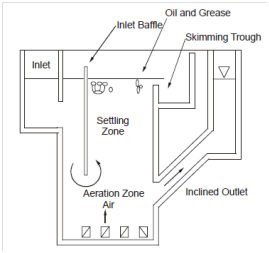Oil And Grease Removal
Major sources of oil and grease involve kitchens, slaughterhouses, restaurants, and garages. Their removal from wastewater is essential since of the subsequent:
(a) They protect tank walls of subsequent sewage treatment plant facilities from grease deposits.
(b) They protect the biological processes, especially air diffusers from grease deposits.
(c) The oil and grease adversely affect bacteria and protozoa life, which is essential in bio-treatment.
(d) Oil and grease are difficult to digest; hence the cost of digestion is increased.
Oil and grease are generally lighter than water; thereby they float (i.e., rise to surface). Oil and grease removal can be achieved in skimming tanks (Figure 4). In the aeration zone, air is injected into the lower level. Settling zone serves as the area to facilitate rising of oil and grease to the surface. Retention time is kept between 10-15 min. Extraction of oil and grease is achieved by either through manual extraction or mechanical skimming of surface or through overflowing.

Figure 4: Oil and Grease Removal